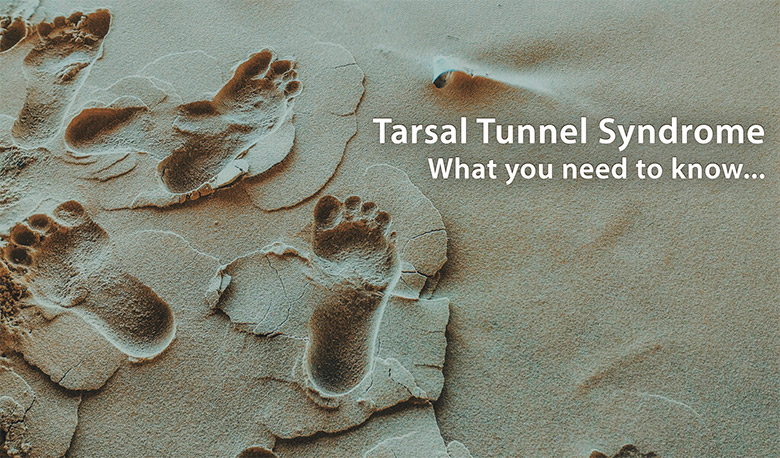At JCMG Podiatry we see an increased number of patients dealing with acute and chronic heel pain. In some cases this pain is associated with a condition known as tarsal tunnel syndrome. Tarsal tunnel syndrome in many ways parallels carpal tunnel syndrome in the hand and wrist.
The tarsal tunnel is located along the inside portion of the ankle and contains blood vessels, the tibial nerve and its branches as well as a number of tendons. The roof of the tarsal tunnel is a structure known as the flexor retinaculum. The flexor retinaculum is a tight structure and limits the amount of space in which the tibial nerve and surrounding structures can move.
Most patients who are suffering from tarsal tunnel syndrome present with a variety of symptoms, but pain and burning seem to be the most common. Pain can and often does radiate to the heel and into the arch of the foot. Additionally, cramping of the muscles into the arch can occur in the early and sub-acute stages of this condition. Numbness and tingling routinely develop as the condition progresses. It is not uncommon for numbness and tingling to extend into the toes.
Tarsal tunnel syndrome can develop for a number of reasons. The most common causes of tarsal tunnel syndrome are:
- A direct injury to the nerve as a result of a severe sprain or fracture
- Venous reflux or varicose vein formation overlying the tibial nerve
- Cyst formation deep within or superficial to the tarsal tunnel
- Systemic conditions like diabetes
- Foot deformities such a decreased arch height
In each of these situations the tibial nerve becomes compressed and loses its ability to send the proper signal to the soft tissue structures it controls. Once the syndrome is activated, pain develops. At first pain may be intermittent in nature and relieved with rest and elevation of the limb, but as the condition progresses, pain becomes more consistent throughout the day.
Generally speaking, patients typically wait a prolonged period of time before presenting to their doctor after the onset of symptoms. This is both understandable and problematic. Obviously, very few people run to the doctor’s office at the first sign of every ache or pain that develops, but in this case as the duration of symptoms increase, the harder it becomes for conservative care to be effective.
Multiple modalities are used to help aid in the diagnosis of tarsal tunnel syndrome for patients, but ultimately the diagnosis is primarily based on a thorough history and physical exam. Oftentimes x-rays, MRIs and even a test to check the ability of the nerve to send the proper speed and strength of its signal (this test is called an EMG/NCV) are performed to help confirm the diagnosis of tarsal tunnel syndrome.
Non-surgical treatment options are attempted in an effort reduce the symptoms associated with tarsal tunnel syndrome, but they are often ineffective. Injection therapy, custom orthotics and physical therapy can all be helpful, but unless you address the root cause of the problem the symptoms will recur and ultimately the patient will be frustrated.
In most cases the tibial nerve will require decompression via a short outpatient surgical procedure. An incision is made over the inside portion of the ankle and the retinaculum overlying the tibial nerve is released and the nerve is freed of any surrounding adhesions. If any varicosities are noted overlying the tibial nerve during the procedure they are ligated as necessary. Intra-operatively if a cyst is present it will also be excised in order to relieve the compression of the tibial nerve. Once the tibial nerve has been freed of any compressive structures, the skin is repaired and a dressing applied to the operative limb. The retinaculum is not repaired in an effort to decrease the potential of scarring in the area. Any scarring could cause recurrent compression of the tibial nerve.
Tarsal tunnel syndrome is a very frustrating condition for patients. At JCMG Podiatry we have successfully treated a large number of patients suffering from this condition. Our goal is to get each patient back to their activities as quickly and as safely as possible, and reduce the risk of recurrence for this problem. If you have been suffering with acute or chronic heel pain that hasn’t responded to conservative care, you will benefit from a thorough podiatric history and physical examination to ensure that you are not suffering with tarsal tunnel syndrome. Same day and next day appointments are available at JCMG Podiatry. Please call (573) 556-7724.

